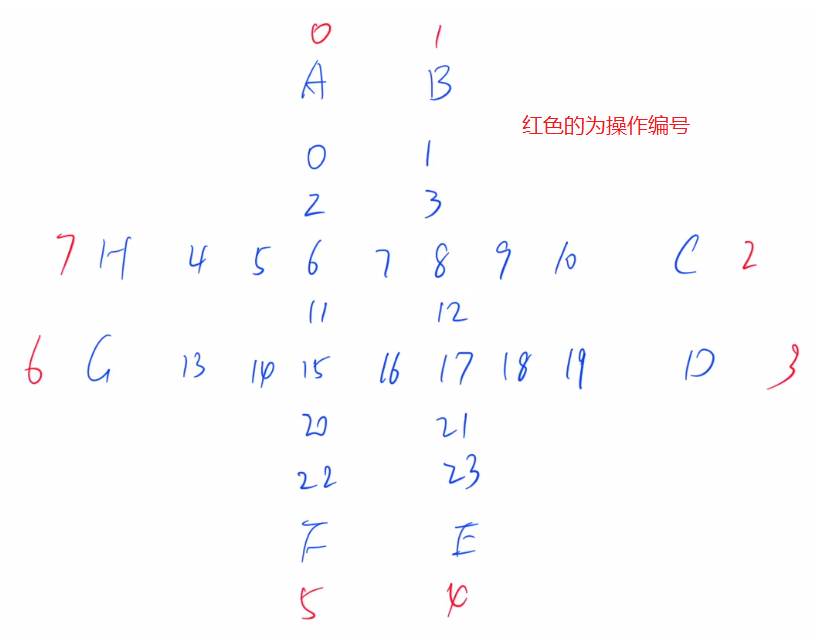分析
-
每次都可以进行8种操作中的一种,这样就可以形成一棵树,暴搜即可。
-
如果存在多种以最少的方案,输出字典序最小的方案:我们只需要按照A~H的顺序枚举每一种操作即可。
-
如何计算我们的估价函数?即当前状态到最终状态还需要的步数:
每次操作我们最多改变中间8个格子中某一个格子的值,因此我们可以统计中间8个格子上出现次数最多的数字的出现次数maxv,则我们至少还需要8-maxv次操作才可能到达最终状态。
- 各个位置的编码以及操作编码如下:

/*
0 1
2 3
4 5 6 7 8 9 10
11 12
13 14 15 16 17 18 19
20 21
22 23
*/
#include <iostream>
#include <cstring>
using namespace std;
const int N = 24;
int op[8][7] = { // 8个方向操作数据的编号
{0, 2, 6, 11, 15, 20, 22},
{1, 3, 8, 12, 17, 21, 23},
{10, 9, 8, 7, 6, 5, 4},
{19, 18, 17, 16, 15, 14, 13},
{23, 21, 17, 12, 8, 3, 1},
{22, 20, 15, 11, 6, 2, 0},
{13, 14, 15, 16, 17, 18, 19},
{4, 5, 6, 7, 8, 9, 10}
};
// 正向操作是0、1、2、3、4、5、6、7,如下是对应反向操作
int oppsite[8] = {5, 4, 7, 6, 1, 0, 3, 2};
// 中心八个数据的位置编号
int center[8] = {6, 7, 8, 11, 12, 15, 16, 17};
int q[N];
int path[100]; // path用于存储方案
// 估价函数
int f() {
static int sum[4];
memset(sum, 0, sizeof sum);
for (int i = 0; i < 8; i++) sum[q[center[i]]]++;
int maxv = 0;
for (int i = 1; i <= 3; i++) maxv = max(maxv, sum[i]);
return 8 - maxv;
}
// 进行数字x对应的操作
void operate(int x) {
int t = q[op[x][0]];
for (int i = 0; i < 6; i++) q[op[x][i]] = q[op[x][i + 1]];
q[op[x][6]] = t;
}
// depth: 当前迭代深度; max_depth: 迭代加深最大深度, last: 上一次操作
bool dfs(int depth, int max_depth, int last) {
if (depth + f() > max_depth) return false;
if (f() == 0) return true;
for (int i = 0; i < 8; i++)
if (oppsite[i] != last) {
operate(i);
path[depth] = i;
if (dfs(depth + 1, max_depth, i)) return true;
operate(oppsite[i]);
}
return false;
}
int main() {
while (cin >> q[0], q[0]) {
for (int i = 1; i < 24; i++) cin >> q[i];
int depth = 0;
while (!dfs(0, depth, -1)) depth++;
if (!depth) printf("No moves needed");
else {
for (int i = 0; i < depth; i++) printf("%c", 'A' + path[i]);
}
printf("\n%d\n", q[6]);
}
return 0;
}

